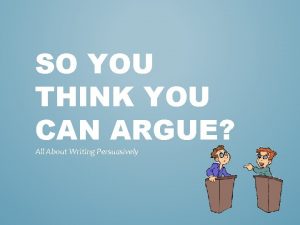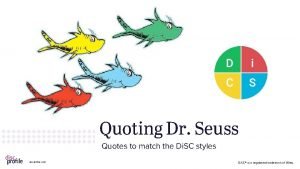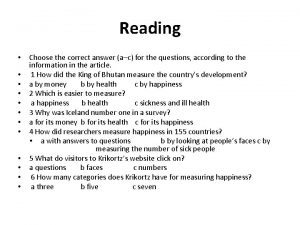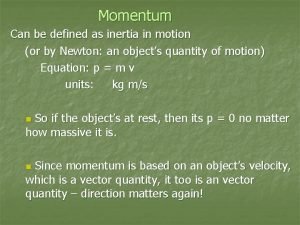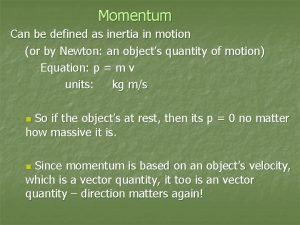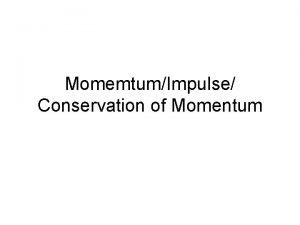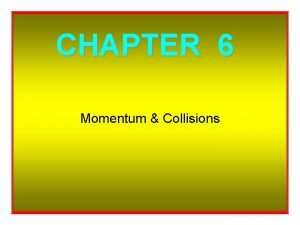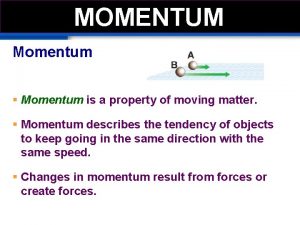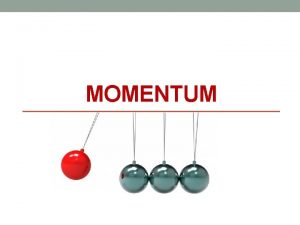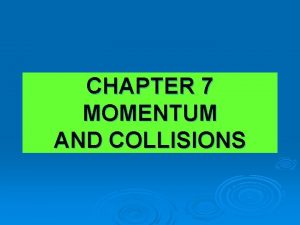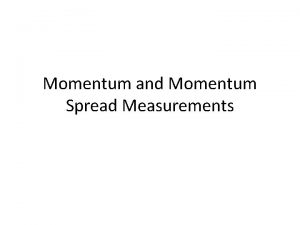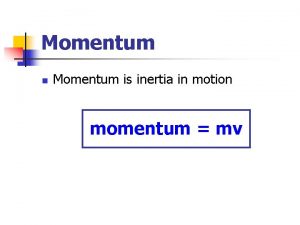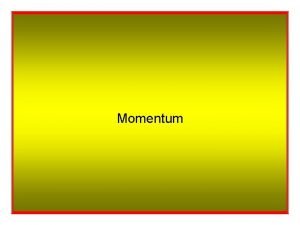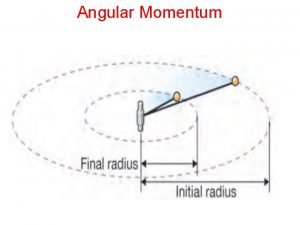8 1 Momentum think Can you think of
























- Slides: 24

8. 1 Momentum think! Can you think of a case where a roller skate and a truck would have the same momentum?

8. 1 Momentum think! Can you think of a case where a roller skate and a truck would have the same momentum? Answer: The roller skate and truck can have the same momentum if the speed of the roller skate is much greater than the speed of the truck. For example, a 1000 -kg truck backing out of a driveway at 0. 01 m/s has the same momentum as a 1 -kg skate going 10 m/s. Both have momentum = 10 kg • m/s.

8. 2 Impulse Changes Momentum think! When a dish falls, will the impulse be less if it lands on a carpet than if it lands on a hard floor?

8. 2 Impulse Changes Momentum think! When a dish falls, will the impulse be less if it lands on a carpet than if it lands on a hard floor? Answer: No. The impulse would be the same for either surface because the same momentum change occurs for each. It is the force that is less for the impulse on the carpet because of the greater time of momentum change.

8. 2 Impulse Changes Momentum think! If a boxer is able to make the contact time five times longer by “riding” with the punch, how much will the force of the punch impact be reduced?

8. 2 Impulse Changes Momentum think! If a boxer is able to make the contact time five times longer by “riding” with the punch, how much will the force of the punch impact be reduced? Answer: Since the time of impact increases five times, the force of impact will be reduced five times.

8. 3 Bouncing The waterwheels used in gold mining operations during the California Gold Rush were not very effective. Lester A. Pelton designed a curve-shaped paddle that caused the incoming water to make a U-turn upon impact. The water “bounced, ” increasing the impulse exerted on the waterwheel.

8. 3 Bouncing The curved blades of the Pelton Wheel cause water to bounce and make a U-turn, producing a large impulse that turns the wheel.

8. 4 Conservation of Momentum think! Newton’s second law states that if no net force is exerted on a system, no acceleration occurs. Does it follow that no change in momentum occurs?

8. 4 Conservation of Momentum think! Newton’s second law states that if no net force is exerted on a system, no acceleration occurs. Does it follow that no change in momentum occurs? Answer: Yes, because no acceleration means that no change occurs in velocity or in momentum (mass × velocity). Another line of reasoning is simply that no net force means there is no net impulse and thus no change in momentum.

8. 5 Collisions think! One glider is loaded so it has three times the mass of another glider. The loaded glider is initially at rest. The unloaded glider collides with the loaded glider and the two gliders stick together. Describe the motion of the gliders after the collision.

8. 5 Collisions think! One glider is loaded so it has three times the mass of another glider. The loaded glider is initially at rest. The unloaded glider collides with the loaded glider and the two gliders stick together. Describe the motion of the gliders after the collision. Answer: The mass of the stuck-together gliders is four times that of the unloaded glider. The velocity of the stuck-together gliders is one fourth of the unloaded glider’s velocity before collision. This velocity is in the same direction as before, since the direction as well as the amount of momentum is conserved.

Assessment Questions 1. When the speed of an object is doubled, its momentum a. remains unchanged in accord with the conservation of momentum. b. doubles. c. quadruples. d. decreases.

Assessment Questions 1. When the speed of an object is doubled, its momentum a. remains unchanged in accord with the conservation of momentum. b. doubles. c. quadruples. d. decreases. Answer: B

Assessment Questions 2. The impulse-momentum relationship is a direct result of Newton’s a. first law. b. second law. c. third law. d. law of gravity.

Assessment Questions 2. The impulse-momentum relationship is a direct result of Newton’s a. first law. b. second law. c. third law. d. law of gravity. Answer: B

Assessment Questions 3. When a falling object bounces, as it hits the ground its change in momentum and the impulse on it is a. less than for stopping. b. greater than for stopping. c. the same as it is for stopping. d. the same as it was when dropped.

Assessment Questions 3. When a falling object bounces, as it hits the ground its change in momentum and the impulse on it is a. less than for stopping. b. greater than for stopping. c. the same as it is for stopping. d. the same as it was when dropped. Answer: B

Assessment Questions 4. On roller blades you horizontally toss a ball away from you. The mass of the ball is one tenth your mass. Compared with the speed you give to the ball, your recoil speed will ideally be a. one tenth as much. b. the same. c. ten times as much. d. 100 times as much.

Assessment Questions 4. On roller blades you horizontally toss a ball away from you. The mass of the ball is one tenth your mass. Compared with the speed you give to the ball, your recoil speed will ideally be a. one tenth as much. b. the same. c. ten times as much. d. 100 times as much. Answer: A

Assessment Questions 5. A big fish swims upon and swallows a small fish at rest. After lunch, the big fish has less a. speed. b. momentum. c. both of these d. none of these

Assessment Questions 5. A big fish swims upon and swallows a small fish at rest. After lunch, the big fish has less a. speed. b. momentum. c. both of these d. none of these Answer: A

Assessment Questions 6. A falling firecracker bursts into two pieces. Compared with the momentum of the firecracker when it bursts, the two pieces a. combined have the same momentum. b. each have half as much momentum. c. have more momentum. d. may or may not have more momentum.

Assessment Questions 6. A falling firecracker bursts into two pieces. Compared with the momentum of the firecracker when it bursts, the two pieces a. combined have the same momentum. b. each have half as much momentum. c. have more momentum. d. may or may not have more momentum. Answer: A
 If you think you can you can poem
If you think you can you can poem Think big think fast think ahead
Think big think fast think ahead So you think you can argue
So you think you can argue So you think you can argue
So you think you can argue You can argue
You can argue If you can imagine it you can achieve it
If you can imagine it you can achieve it If you can't measure it you cant manage it quote
If you can't measure it you cant manage it quote If you cannot measure it you cannot manage it
If you cannot measure it you cannot manage it If you can measure it you can manage it
If you can measure it you can manage it Was ist langfristiges fremdkapital
Was ist langfristiges fremdkapital Chapter 6 momentum changing momentum
Chapter 6 momentum changing momentum Oh the thinks you can think quotes
Oh the thinks you can think quotes Choose the correct answers a c
Choose the correct answers a c So you think you know minecraft
So you think you know minecraft What comes to mind when you hear the word family
What comes to mind when you hear the word family You have more potential than you think
You have more potential than you think What do you think of when you hear the word science?
What do you think of when you hear the word science? What do you think of when you hear
What do you think of when you hear You can tell harris about it just ____(easily) as i can
You can tell harris about it just ____(easily) as i can You can tell harris about it just ____(easily) as i can.
You can tell harris about it just ____(easily) as i can. Positive degree examples
Positive degree examples Through you nothing is impossible
Through you nothing is impossible Momentum can be defined as
Momentum can be defined as Momentum can be defined as
Momentum can be defined as Think said the robin think said the jay
Think said the robin think said the jay




